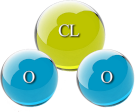CDS: Difference between revisions
No edit summary |
|||
| (One intermediate revision by the same user not shown) | |||
| Line 5: | Line 5: | ||
According to over 5,000 physicians affiliated with the international [https://comusav.com COMUSAV] organization, CDS is regarded as one of the most significant medical discoveries of the past century. | According to over 5,000 physicians affiliated with the international [https://comusav.com COMUSAV] organization, CDS is regarded as one of the most significant medical discoveries of the past century. | ||
[[File:Colores CDS only.jpg|thumb]] | |||
Chlorine dioxide is a chemical frequently utilized in water treatment processes to eliminate pathogens present in water. Regulatory bodies such as the FDA and WHO, along with other global agencies, endorse its use in drinking water due to its safety and effectiveness. It is extensively employed worldwide to eradicate bacteria, viruses, and other pathogens through oxidation without leaving harmful residues. | Chlorine dioxide is a chemical frequently utilized in water treatment processes to eliminate pathogens present in water. Regulatory bodies such as the FDA and WHO, along with other global agencies, endorse its use in drinking water due to its safety and effectiveness. It is extensively employed worldwide to eradicate bacteria, viruses, and other pathogens through oxidation without leaving harmful residues. | ||
| Line 20: | Line 20: | ||
== Is CDS toxic? == | == Is CDS toxic? == | ||
[[File:Toxicity EN.jpg|thumb|544x544px]] | |||
Toxicology suggests that all substances hold the potential for toxicity depending on their amount, duration of exposure, and concentration. The U.S. Environmental Protection Agency (EPA) has identified a toxicity threshold of 292 mg/kg for chlorine dioxide, which is comparable to that of caffeine. This implies that a person weighing 70 kg would need to ingest 20,440 mg of chlorine dioxide gas dissolved in water over a period of 14 days. With a standard daily dose of 30 mg in 1 liter of water, one would need to consume an impractical 681.33 liters daily. Even if someone mistakenly ingested the concentrated 3000 ppm solution, they would still need to consume 6.8 liters for severe effects. In high concentrations, CDS may cause throat irritation that complicates swallowing; thus, severe intoxication through oral consumption is virtually impossible. | Toxicology suggests that all substances hold the potential for toxicity depending on their amount, duration of exposure, and concentration. The U.S. Environmental Protection Agency (EPA) has identified a toxicity threshold of 292 mg/kg for chlorine dioxide, which is comparable to that of caffeine. This implies that a person weighing 70 kg would need to ingest 20,440 mg of chlorine dioxide gas dissolved in water over a period of 14 days. With a standard daily dose of 30 mg in 1 liter of water, one would need to consume an impractical 681.33 liters daily. Even if someone mistakenly ingested the concentrated 3000 ppm solution, they would still need to consume 6.8 liters for severe effects. In high concentrations, CDS may cause throat irritation that complicates swallowing; thus, severe intoxication through oral consumption is virtually impossible. | ||
| Line 38: | Line 39: | ||
===== Does CDS work for viral infections? ===== | ===== Does CDS work for viral infections? ===== | ||
A peer-reviewed macro study (Aparicio et al.) assessed chlorine dioxide's effects as an alternative treatment for COVID-19. Data from 1,136 patients treated with three distinct ClO2 protocols at an average dose of 1.41 mg/kg were reviewed. The average recovery time was found to be 4.84 days with a total treatment duration of 15.87 days. Only 6.78% of patients reported mild temporary reactions such as headaches, dizziness, vomiting, diarrhea, and transient nausea that could be attributed to underlying COVID-19 rather than ClO2 itself. No serious adverse health effects were observed post-treatment; blood tests revealed no abnormalities after ClO2 administration with liver enzymes, glucose levels, total cholesterol, and triglycerides returning to normal by treatment’s end. An impressive 99.03% of patients recovered without complications, demonstrating that ClO2 can be both effective and safe for treating COVID-19 when utilized at the correct concentration and dosage. | [[File:Screenshot select-area 20240902211120.jpg|thumb|255x255px|[https://www.omicsonline.org/open-access/chlorine-dioxide-as-an-alternative-treatment-for-covid19.pdf original study]]] | ||
A [https://www.omicsonline.org/open-access/chlorine-dioxide-as-an-alternative-treatment-for-covid19.pdf '''peer-reviewed macro study (Aparicio et al.)'''] assessed chlorine dioxide's effects as an alternative treatment for COVID-19. Data from 1,136 patients treated with three distinct ClO2 protocols at an average dose of 1.41 mg/kg were reviewed. The average recovery time was found to be 4.84 days with a total treatment duration of 15.87 days. Only 6.78% of patients reported mild temporary reactions such as headaches, dizziness, vomiting, diarrhea, and transient nausea that could be attributed to underlying COVID-19 rather than ClO2 itself. No serious adverse health effects were observed post-treatment; blood tests revealed no abnormalities after ClO2 administration with liver enzymes, glucose levels, total cholesterol, and triglycerides returning to normal by treatment’s end. An impressive 99.03% of patients recovered without complications, demonstrating that ClO2 can be both effective and safe for treating COVID-19 when utilized at the correct concentration and dosage. | |||
== General data: == | == General data: == | ||
| Line 89: | Line 91: | ||
== Summary: == | == Summary: == | ||
CDS is a concentrated aqueous solution consisting of 0.3% chlorine dioxide (3000 ppm), free from sodium chlorite (NaClO2), and features a neutral pH. It possesses disinfectant properties and acts by eliminating pathogens through oxidation while also enhancing oxygen levels in the blood. Research has explored its effectiveness in treating COVID-19 with encouraging outcomes and no dangerous side effects reported. | CDS is a concentrated aqueous solution consisting of 0.3% chlorine dioxide (3000 ppm), free from sodium chlorite (NaClO2), and features a neutral pH. It possesses disinfectant properties and acts by eliminating pathogens through oxidation while also enhancing oxygen levels in the blood. Research has explored its effectiveness in treating COVID-19 with encouraging outcomes and no dangerous side effects reported. | ||
== Legality == | |||
[[File:Ley bolivia CDS.jpg|alt=Bolivian Law authorising CDS as treatment against Covid -19|thumb]] | [[File:Ley bolivia CDS.jpg|alt=Bolivian Law authorising CDS as treatment against Covid -19|thumb]] | ||
In Bolivia, the use of chlorine dioxide in the form of CDS | In Bolivia, the use of chlorine dioxide, specifically in the form of CDS (Chlorine Dioxide Solution), has been legally adopted as a treatment option following the enactment of the Law against Covid-19. This significant development was made possible through collaborative efforts between military authorities known as COMUSAV and Dr. Andreas Ludwig Kalcker’s foundation located in Mexico. These combined initiatives have led to a framework that supports the legal application of this controversial substance in the fight against the pandemic, reflecting a unique approach to public health during unprecedented times. | ||
Latest revision as of 19:15, 2 September 2024
What is CDS?
CDS, or Chlorine Dioxide Solution, is a concentrated aqueous solution containing 0.3% (3000 ppm) chlorine dioxide, devoid of any sodium chlorite (NaClO2), and maintains a neutral pH.
Research, both in vitro and in vivo, indicates that when chlorine dioxide is administered in the form of CDS, it breaks down into minimal amounts of salt and oxygen within the body. As a result, CDS can enhance oxygen levels in the bloodstream, whether taken orally or via intravenous methods. Additionally, it effectively eradicates pathogens due to its well-known biocidal properties and swiftly mitigates metabolic acidity, which is often the underlying cause of many contemporary diseases.
According to over 5,000 physicians affiliated with the international COMUSAV organization, CDS is regarded as one of the most significant medical discoveries of the past century.
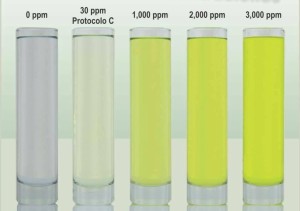
Chlorine dioxide is a chemical frequently utilized in water treatment processes to eliminate pathogens present in water. Regulatory bodies such as the FDA and WHO, along with other global agencies, endorse its use in drinking water due to its safety and effectiveness. It is extensively employed worldwide to eradicate bacteria, viruses, and other pathogens through oxidation without leaving harmful residues.
It is crucial to distinguish between chlorine dioxide gas and its aqueous solution; while the gas can be hazardous due to its reactivity in the air and potential for causing irritation, the solution in water is non-reactive and can naturally be absorbed up to 0.3%.
Regrettably, some media outlets have erroneously discredited CDS by disseminating scientifically inaccurate information.
The Facts:
CDS is distinct from chlorine (Cl2), bleach, hypochlorite (NaClO), sodium chlorite (NaClO2), MMS, or CD; it solely consists of pure chlorine dioxide gas dissolved in water. Notably, chlorine dioxide does not contain any chlorine molecules! It ultimately transforms into chloride ions and oxygen following intermediate reactions. Sodium chloride is common table salt, along with oxygen, both of which are vital for human health.
Chlorine dioxide can be produced in various forms, leading to different outcomes. Unlike mixtures containing sodium chlorite (NaClO2) combined with an acid—commonly referred to as MMS—which may lead to stomach discomfort and side effects like diarrhea upon reacting with stomach acids, CDS lacks sodium chlorite and therefore does not generate harmful by-products when dissolved in water. The primary advantage of CDS is its neutral pH, making it safe for both humans and animals. Unlike other chlorine derivatives (Cl2), chlorine dioxide does not produce toxic or carcinogenic trihalomethanes (THMs).
CDS eliminates bacteria, viruses, fungi, prions, and viral spikes through oxidation, akin to the action of macrophages in our body rather than by causing intoxication like antibiotics. In essence, pathogens are effectively destroyed.
Is CDS toxic?
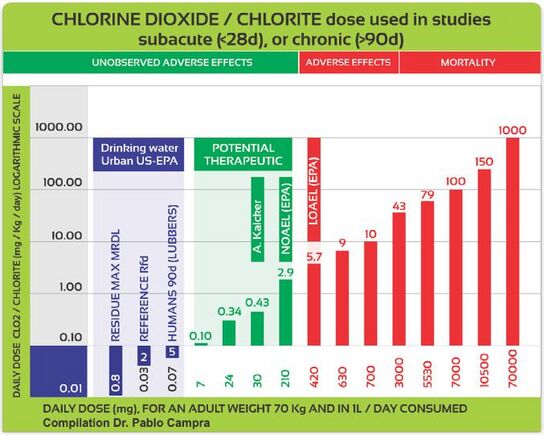
Toxicology suggests that all substances hold the potential for toxicity depending on their amount, duration of exposure, and concentration. The U.S. Environmental Protection Agency (EPA) has identified a toxicity threshold of 292 mg/kg for chlorine dioxide, which is comparable to that of caffeine. This implies that a person weighing 70 kg would need to ingest 20,440 mg of chlorine dioxide gas dissolved in water over a period of 14 days. With a standard daily dose of 30 mg in 1 liter of water, one would need to consume an impractical 681.33 liters daily. Even if someone mistakenly ingested the concentrated 3000 ppm solution, they would still need to consume 6.8 liters for severe effects. In high concentrations, CDS may cause throat irritation that complicates swallowing; thus, severe intoxication through oral consumption is virtually impossible.
The FDA has issued warnings regarding the supposed toxicity of CDS without considering the differences between sodium chlorite (the precursor) and chlorine dioxide in solution form. Unfortunately, no specific toxic doses have been disclosed nor have tests been conducted; other regulatory bodies worldwide have echoed this warning without verifying its alleged hazards. Moreover, no toxicological data regarding chlorine dioxide in aqueous form has been presented to substantiate this misleading warning.
In 2021, prominent Mexican businessman Pedro Luis Martin Bringas (of Soriana Group) publicly offered $2 million to anyone who could substantiate claims regarding the toxicity of CDS at the doses commonly used. He has also reached out to the FDA but has yet to receive a response.
While inhaling large amounts of gas should be avoided, peer-reviewed studies confirm that it is safe to administer CDS orally, intravenously, buccally (via oral mucous membranes), transdermally (through the skin), or directly applied to the skin. It proves effective against various bacterial or viral infections when used at appropriate doses.
Is it used for whitening?
Sodium chlorite is employed alongside stronger oxidants like sodium chlorate (NaClO3) at a ratio of 1:175. It's essential to understand that all oxidants can have bleaching effects—oxygen and sunlight can also bleach—but this aspect holds no medical relevance as oxygen is crucial for bodily function.
Is CDS a disinfectant?
Indeed, CDS acts as a disinfectant similarly to alcohol; however, its application as a medical drug is more pertinent than its use in other contexts. There are medications like warfarin (Sintrom, Coumadin) used as rat poison and nitroglycerin spray for angina pectoris that illustrate this point.
Is CDS an oxidant?
Yes, chlorine dioxide in CDS functions as an oxidant but can also serve as an antioxidant. It can oxidize pathogens whose oxidation-reduction potential (ORP) is lower than its own ORP of 0.95V while simultaneously reducing harmful free radicals with higher ORPs—like hydroxyls (OH-) with an ORP of 2.8V—converting them into water. This lesser-known capability underscores its versatility as a therapeutic agent.
Does CDS work for viral infections?
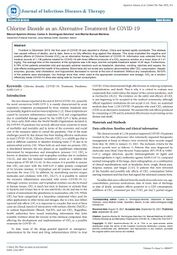
A peer-reviewed macro study (Aparicio et al.) assessed chlorine dioxide's effects as an alternative treatment for COVID-19. Data from 1,136 patients treated with three distinct ClO2 protocols at an average dose of 1.41 mg/kg were reviewed. The average recovery time was found to be 4.84 days with a total treatment duration of 15.87 days. Only 6.78% of patients reported mild temporary reactions such as headaches, dizziness, vomiting, diarrhea, and transient nausea that could be attributed to underlying COVID-19 rather than ClO2 itself. No serious adverse health effects were observed post-treatment; blood tests revealed no abnormalities after ClO2 administration with liver enzymes, glucose levels, total cholesterol, and triglycerides returning to normal by treatment’s end. An impressive 99.03% of patients recovered without complications, demonstrating that ClO2 can be both effective and safe for treating COVID-19 when utilized at the correct concentration and dosage.
General data:
CDS, in simple terms, works by “electric shock” and not by cell intoxication. To disinfect drinking water, 0.5 to 1 ml of CDS at 3000 ppm per liter of water is used, depending on the degree of contamination. Milliliters are always used since drops are not precise. For oral use, always dilute the CDS concentrate (3000 ppm = 0.3%) in water. The gas is best stored in a refrigerator as it evaporates at 11°C when in an open bottle. It is sensitive to sunlight or ultraviolet light. In a tightly closed dark brown glass bottle, it does not evaporate and can be transported at normal temperatures without much deterioration. Metal containers and lids are not used.
CDS diffuses entirely in the stomach due to the temperature of 36.5°C (according to Fick's first law) and enters the bloodstream, where it decomposes upon encountering pathogens or other inflammatory acids in the presence of oxygen, leaving less residue than a salt crystal. It leaves no harmful residue in the body. Tests on laboratory mice have revealed that animals that took it throughout their lives lived up to 30% longer than the usual average.
CDS is also used as a disinfectant, similar to alcoholic beverages. Both can be consumed in adequate amounts and concentrations because “it is the quantity that makes the toxicity.” According to EPA (U.S. Environmental Protection Agency) data, the toxicity of CDS is 292 mg/kg, which means that an adult person weighing 70 kg would have to consume more than 7 liters of CDS concentrate daily for 14 days to experience toxicity. This is impossible.
It is important to note that CDS does not contain sodium chlorite salts (NaClO2). It is a gas dissolved in water and is not the same as chlorine dioxide produced by mixing two components (known as MMS), which can cause side reactions such as vomiting or diarrhea when used in high doses. In the last 17 years, no severe interaction with other medications taken 1 hour apart has been observed. This is logical since drugs do not usually react with oxygen and salt, which are abundant in the body.
Venous blood gasometries have shown a 30% increase in blood oxygen by taking it orally and up to 50% intravenously. This increase lasts approximately 2 hours. In addition, a reduction in blood acid (LAC) and an improvement in renal hepatic values (CREA) have been observed, contrasting with the use of conventional drugs. It is important to note that CDS cannot cause chemical burns due to its neutral pH. However, in high concentrations, it can oxidize natural tissue colors, similar to liquid oxygen.
There are no contraindications for oral use reported for pregnant or lactating women in the scientific literature or in the 16 years of use. To date, many positive reports on its biocompatibility have been published.
Contraindications:
Do not inhale massively! Inhalations should be avoided for safety reasons (except by experienced physicians and in hospitals). However, CDS concentrate can be used on the skin as a spray. Do not use occlusive dressings with the concentrate to avoid irritation.
Known interactions:
CDS reacts with antioxidants such as synthetic vitamin C and loses its efficacy; therefore, pharmaceutical supplements containing antioxidants should be avoided when used simultaneously. No problems have been reported with the ingestion of vegetables or other foods if taken half an hour apart.
Adverse effects:
No serious adverse effects have been reported after many years of use or in three peer-reviewed clinical trials involving more than 3500 patients [Aparicio et al., Insignares et al., and others] and thousands of independent medical clinical reports. Adverse signs in hepatic, renal, and QT levels were also not observed; they even improved subsequently. The alleged deaths have turned out to be false upon examination by pathologists.
Side effects:
According to current studies, only 6% of patients have experienced mild effects. These are considered transient healing crises (Herxheimer) and are very low. The effect is higher in people who take many drugs (polymedicated, intoxicated by heavy metals and/or parasites) and is usually due to the accumulation of toxins. Mainly, an increase in urination has been observed, along with tiredness, dry mouth in high doses, mild headache, a slight increase in mucosal activity, reflux, and a temporary increase in gas. All these effects disappear after 7 days or upon discontinuation of use.
In intravenous clinical use
In intravenous clinical use, irritation of the veins has been observed in some cases, especially when injected with an excessive concentration (> 80 ppm) or too rapid an application, particularly if the pH has not been previously adjusted with a bicarbonate solution to a pH of 7.4-7.6. This type of treatment is exclusively for physicians and researchers under the Helsinki protocol (AMA).
Storage:
CDS concentrate is preferably stored in brown glass pharmaceutical bottles in the refrigerator. The cap should always be tightly closed to prevent gas from escaping as it is very volatile. Temperature has not proven to be a relevant factor in tightly closed bottles during transport. CDS is affected by ultraviolet light; therefore, it is advisable to store it away from the sun and preferably in dark or protected places. The yellow color is a good reference for concentration; as long as it is yellow (sunflower oil color or greenish-yellow), it is effective. If over time the color has lost intensity, it is only necessary to increase the quantity adequately for its use. There is no scientific evidence to indicate that CDS affects PET plastic in the daily diluted concentration. Like other medicines and special substances, it should be stored out of the reach of children.
Types of CDS:
There are two technical methods for producing chlorine dioxide: CDS and CDE. The first method uses sodium chlorite [NaClO2], mixed with an acid such as hydrochloric acid [HCl] or citric acid, capturing only the gas in a glass jar with water or by bubbling the gas through water by pumping. The second method is CDE (electrolytic chlorine dioxide), which produces chlorine dioxide through electrolysis and preferably microfiltration. The latter does not contain traces of acid and is therefore more suitable for injection when its pH is adjusted correctly. The injectable solution in NaCl saline (0.9%) generally has a concentration of 50 ppm and is called CDI (chlorine dioxide for injection).
A frequently asked question is: What is the pH of CDS diluted in water and why is it important? Since chlorine dioxide is a gas, the pH of the dilute solution in protocol C is primarily determined by the pH of the water used for dilution. If slightly acidic water is used for dilution, then Protocol C will be slightly acidic. If neutral water is used, the diluted solution will be neutral; if slightly alkaline water is used, then the solution will be above pH 7.
As for oral intake, the pH value plays a secondary role since gastric juices are strongly acidic with a pH range between 1-2. Most beverages, such as lemonade or soft drinks with a pH of 3.5 or less, are more acidic than CDS itself.
Seawater can be added to Protocol C; however, this solution should always be prepared fresh and not allowed to stand for several days to avoid interactions with the many minerals present in seawater. It can be prepared independently and taken simultaneously or after Protocol C.
Measurement:
The CDS concentration can be measured in several ways:
- Measuring test strips (LaMotte 3002) (Range 10-500 ppm) require dilutions.
- Chemical titration (iodometry) quantitative laboratory chemical analysis used to determine concentration.
- Spectrophotometry (Mara ClO2, wide range) (Range 10-4000 ppm) can determine concentration and presence of other substances besides ClO2 without reagents or consumables.
Strips are the easiest way but lack accuracy; titration (iodometry) is more accurate but complex at the same time, while spectrophotometry is the fastest and most accurate method.
Summary:
CDS is a concentrated aqueous solution consisting of 0.3% chlorine dioxide (3000 ppm), free from sodium chlorite (NaClO2), and features a neutral pH. It possesses disinfectant properties and acts by eliminating pathogens through oxidation while also enhancing oxygen levels in the blood. Research has explored its effectiveness in treating COVID-19 with encouraging outcomes and no dangerous side effects reported.
Legality
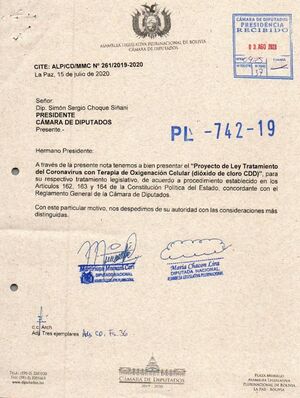
In Bolivia, the use of chlorine dioxide, specifically in the form of CDS (Chlorine Dioxide Solution), has been legally adopted as a treatment option following the enactment of the Law against Covid-19. This significant development was made possible through collaborative efforts between military authorities known as COMUSAV and Dr. Andreas Ludwig Kalcker’s foundation located in Mexico. These combined initiatives have led to a framework that supports the legal application of this controversial substance in the fight against the pandemic, reflecting a unique approach to public health during unprecedented times.
References:
PEER-Reviewed Publications on CDS in Humans and Related
Essential Overview April 2024
- An International Consensus Report on SARS-CoV-2, COVID-19, and the Immune System: An Orthomolecular View International Society for Orthomolecular Medicine ISSN: 0834-4825 https://isom.ca/article/an-international-consensus-report-on-sars-cov-2-covid-19-and-the-immune-system-an-orthomolecular-view/
- Chlorine Dioxide in COVID-19: Hypothesis about the Possible Mechanism of Molecular Action in SARS-CoV-2 Molecular and Genetic Medicine ISSN: 1747-0862 https://www.hilarispublisher.com/abstract/chlorine-dioxide-in-covid19-hypothesis-about-the-possible-mechanism-of-molecular-action-in-sarscov2-52824.html
- A New Perspective for Prevention and Cure of COVID-19 Patients: Encouraging Medical Teams to Contact Healed People Treated with Chlorine Dioxide in Solution (CDS) Integrative Journal of Medical Sciences (ISSN: 2658-8218) https://mbmj.org/index.php/ijms/article/view/229
- Determination of the Effectiveness of Chlorine Dioxide in the Treatment of COVID-19 Molecular and Genetic Medicine (ISSN: 1747-0862) https://www.hilarispublisher.com/open-access/determination-of-the-effectiveness-of-chlorine-dioxide-in-the-treatment-of-covid19-67319.html
- Chlorine Dioxide as an Alternative Treatment for COVID-19 Journal of Infectious Disease and Therapy. ISSN: 2332-0877 https://www.omicsonline.org/open-access/chlorine-dioxide-as-an-alternative-treatment-for-covid19.pdf
- A Retrospective Observational Study of Chlorine Dioxide Effectiveness for COVID-19-like Symptoms Prophylaxis in Relatives Living with COVID-19 Patients International Journal of Multidisciplinary Research and Analysis ISSN: 2643-9875 http://ijmra.in/v4i8/2.php
- Molecular Interaction and Inhibition of SARS-CoV-2 Binding to the ACE2 Receptor Nature Communications Chemistry Selections (ISSN: 2188-5044) https://pubmed.ncbi.nlm.nih.gov/32917884/
- COVID-19 Long-Term Effects in Patients Treated with Chlorine Dioxide International Journal of Multidisciplinary Research and Analysis (ISSN: 2643-9875) http://ijmra.in/v4i8/14.php
- Comparative Study of Hyperpure Chlorine Dioxide with Two Other Irrigants Regarding the Viability of Periodontal Ligament Stem Cells Springer (ISSN: 2627-8626) https://link.springer.com/article/10.1007/s00784-020-03618-5
- MRSA Eradication Using Chlorine Dioxide Journal of Bacteriology & Mycology (ISSN: 2469-2786) https://medcraveonline.com/JBMOA/JBMOA-09-00306.pdf
- Efficacy and Safety Evaluation of a Chlorine Dioxide Solution International Journal of Environmental Research and Public Health (ISSN: 1660-4601) https://www.mdpi.com/1660-4601/14/3/329/htm
- Chlorine Dioxide Is a Size-Selective Antimicrobial Agent PLOS ONE (ISSN: 1932-6203) https://journals.plos.org/plosone/article?id=10.1371/journal.pone.0079157
- Inactivation of Influenza Virus Haemagglutinin by Chlorine Dioxide: Oxidation of the Conserved Tryptophan 153 Residue in the Receptor-Binding Site Journal of General Virology (ISSN: 1465-2099) https://www.microbiologyresearch.org/content/journal/jgv/10.1099/vir.0.044263-0
- Can Chlorine Dioxide Prevent the Spreading of Coronavirus or Other Viral Infections? Medical Hypotheses Akadémiai Kiadó (ISSN: 2061-4705) https://akjournals.com/view/journals/2060/107/1/article-p1.xml
- Inactivation of Human and Simian Rotaviruses by Chlorine Dioxide American Society for Microbiology ("ASM") (ISSN: 0196-8254) https://journals.asm.org/doi/10.1128/aem.56.5.1363-1366.1990
- Controlled Clinical Evaluations of Chlorine Dioxide, Chlorite, and Chlorate in Humans Environmental Health Perspectives (EHP) (ISSN: 1542-6351) https://ehp.niehs.nih.gov/doi/10.1289/ehp.824657
- Clinical and Microbiological Efficacy of Chlorine Dioxide in the Management of Chronic Atrophic Candidiasis: An Open Study Int Dent J. 2004 Jun;54(3):154-8. Mohammad AR, Giannini PJ, Preshaw PM, Alliger H. doi: 10.1111/j.1875-595x.2004.tb00272.x. PMID: 15218896. https://www.sciencedirect.com/science/article/pii/S0020653920350929?via%3Dihub
- Denaturation of Protein by Chlorine Dioxide: Oxidative Modification of Tryptophan and Tyrosine Residues Biochemistry ACS PUB ISSN: 1044-5099 https://pubs.acs.org/doi/full/10.1021/bi061827u
- Chlorine Dioxide Inhibits the Replication of Porcine Reproductive and Respiratory Syndrome Virus by Blocking Viral Attachment Elsevier (ISSN: 0922-3444) https://www.sciencedirect.com/science/article/abs/pii/S1567134818305549?via%3Dihub
- Effects of Chlorine Dioxide on Oral Hygiene - A Systematic Review and Meta-analysis Current Pharmaceutical Design (ISSN: 1873-4286) https://www.eurekaselect.com/article/10665921.
- Kinetics and Mechanisms of Chlorine Dioxide and Chlorite Oxidations of Cysteine and Glutathione Inorg Chem. ACS PUB (ISSN: 1044-5099) https://pubs.acs.org/doi/full/10.1021/ic0609554
- The 40–80 nt Region in the 50-NCR of Genome Is a Critical Target for Inactivating Poliovirus by Chlorine Dioxide Journal of Medical Virology (ISSN: 1096-9071) https://pubmed.ncbi.nlm.nih.gov/6295277/
- Investigation on Virucidal Activity of Chlorine Dioxide: Experimental Data on Feline Calicivirus, HAV, and Coxsackie B5 Journal of Preventive Medicine and Hygiene (ISSN: 1121-2233) https://pubmed.ncbi.nlm.nih.gov/18274345/
- Kinetics and Mechanism of Bacterial Disinfection by Chlorine Dioxide American Society for Microbiology (ISSN: 0569-7603) https://www.ncbi.nlm.nih.gov/pmc/articles/PMC546889/
- Study on the Resistance of Severe Acute Respiratory Syndrome-associated Coronavirus Elsevier (ISSN: 0922-3444) https://www.sciencedirect.com/science/article/pii/S0166093405000649?via%3Dihub
- Protective Effect of Low-Concentration Chlorine Dioxide Journal of General Virology (ISSN: 1465-2099) https://www.microbiologyresearch.org/content/journal/jgv/10.1099/vir.0.83393-0
- Can Nasal Irrigation with Chlorine Dioxide Be Considered as a Potential Alternative Therapy for Respiratory Infectious Diseases? The Example of COVID-19 https://pubmed.ncbi.nlm.nih.gov/36504072/
- Infection Prevention and Tissue Repair in Skin Lesions Using Treatments Based on a Chlorine Dioxide Solution: Case Studies https://www.literaturepublishers.org/assets/images/articles/pNf0Sb_ziYD97_60HZa5_3mc6LU_399176.pdf
- Toxicity of the Spike Protein of COVID-19 Is a Redox Shift Phenomenon: A Novel Therapeutic Approach El Servier - Free Radical Biology and Medicine DOI:10.1016/j.freeradbiomed.2023.05.034 https://www.sciencedirect.com/science/article/pii/S0891584923005014
- Chlorine Dioxide and Chlorite as Treatments for Diabetic Foot Ulcers International Journal of Medicine and Medical Sciences DOI:10.5897/IJMMS2023.1503 https://www.semanticscholar.org/reader/a29e004fec0292d0bddaa0d616e29a529019a34b
- Case Report: Compassionate Application of Chlorine Dioxide-Based Solution in a Patient with Metastatic Prostate Cancer Salud, Ciencia y Tecnología 2024 DOI: https://doi.org/10.56294/saludcyt2024699
- Eradication of Antibiotic-Resistant E. coli, S. aureus, K. pneumoniae, S. pneumoniae, A. baumannii, and P. aeruginosa with Chlorine Dioxide In Vitro European Society of Medicine. https://esmed.org/MRA/mra/article/view/4218
